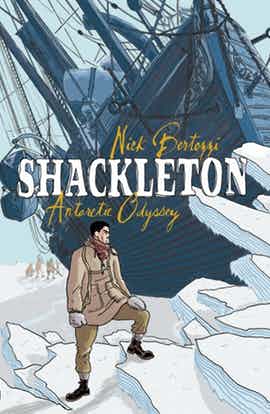
Kate Beaton meets Ken Burns in “Shackleton: Antarctic Odyssey,” a surprisingly jovial retelling of Sir Ernest Shackleton’s 1914-1917 attempt to cross Antarctica on foot. Unlike many tributes to the Imperial Trans-Antarctic Expedition, Nick Bertozzi’s isn’t a celebration of hardiness and tough leadership. Instead, it’s an homage to the lighter, littler ways that people help one another endure — fitting for an expedition that never achieved its stated goal, but did achieve the (perhaps loftier) goal of bringing its crew home alive.
Considering the subject matter, this book is unexpectedly fun. Even at the worst moments of the expedition, Bertozzi doesn’t show Shackleton’s crew planning mutiny or dwelling on the existential boredom of 30+ months in the Antarctic. Rather, they complain about cold toes, wet heads and stinking sealskin blankets. They whine about each other’s habits or the smell of the dogs. When they want to cheer up, they engage in silly, utterly out-of-place activities like a soccer match on the ice, bike rides around the penguin colony or sled rides down icebergs.
This is therefore much less a biography of Shackleton and much more an exploration of the simple discomfort and incongruity of being a human being in the Antarctic. Even the clearest examples of Shackleton’s leadership are limited to one- or two-panel solutions at the end of a longer, more drawn out squabble or debate between the crew members. Bertozzi’s art delights in the ways that otherwise average people can conquer nature through the simple application of practical thinking and measured decision-making. The unendurable cold isn’t matched by indomitable will, but by arithmetic and some compasses.
The art similarly conveys the marvel of the mundane. The black-and-white palette, with some light grey shading, looks simple and stark at the same time. It’s ideal for a polar landscape. The page layouts are both clean and inventive, making neat use of white space to demonstrate everything from the passage of time to the pace of an action.
All the fun aside, this book is a product of meticulous research. Some of the pages are so informative and logically laid out that they read more like infographics than graphic novel pages — and I don’t mean that as an insult. Rather, “Shackleton: Antarctic Odyssey” makes an excellent case for why a graphic novel might tell this story more smoothly and dynamically than another medium. Bertozzi’s layouts are easy to digest and delightful to peruse, driving through the necessary historical exposition quickly and humorously. A nonfiction paragraph that listed every single dog on the expedition might wax tedious at husky #40 in another format, but here they come off as a fun footnote.
The detail involved is also quite enjoyable. I’ve read a few books about Shackleton and Scott, so I was relatively familiar with the dangers of the Antarctic, but “Antarctic Odyssey” walks through the less well-publicized dangers: ice runs, westerly winds, contaminated supplies, etc. with a very human emphasis on the implications.
All together, “Shackleton: Antarctic Odyssey” is an enjoyable way to commemorate the 100th anniversary of the expedition. It’s a great exploration of how courage manifests in practical, problem-solving ways as well as fierce ones.

